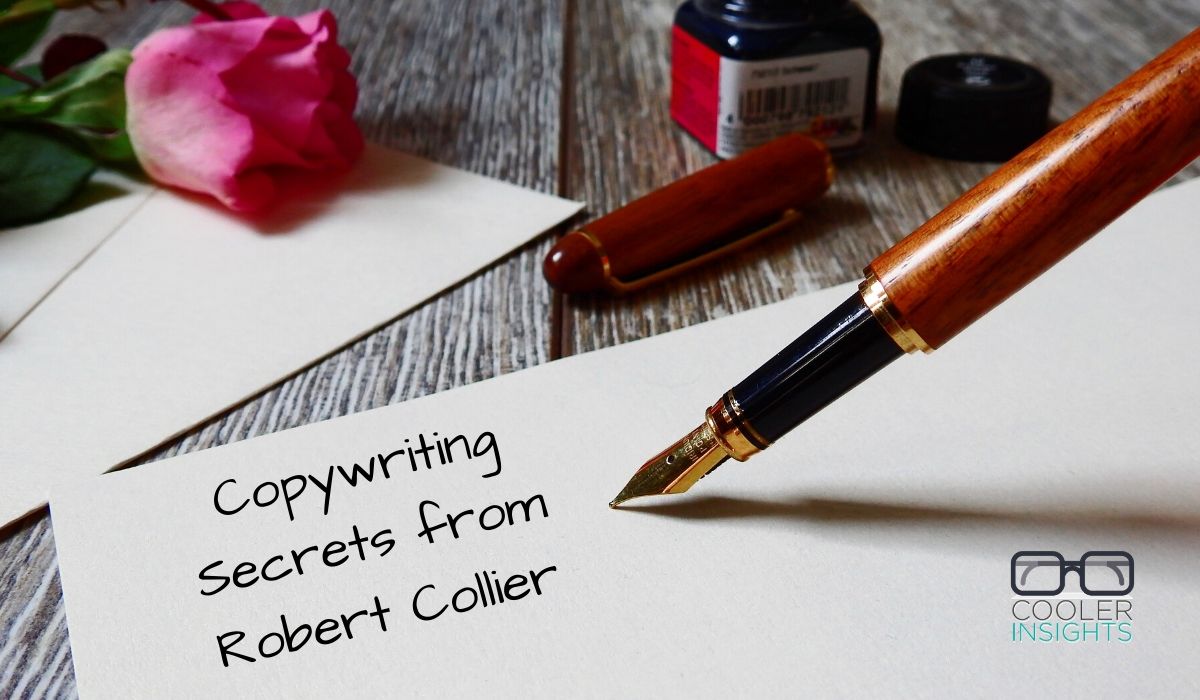
Does your digital copywriting suck? Wish to improve your social media marketing and content marketing performance through more effective copy?
In this series of posts, I’ll be sharing some of the evergreen techniques from the legendary masters of advertising, direct selling and copywriting.
Although their platforms are mostly offline—newspaper ads, magazine ads, posters, banners, newsletters, and direct mail—their evergreen lessons in writing profitable copy are as relevant today as they were decades ago.
For this first article, we will be focusing on Robert Collier—an acclaimed direct marketer in the 1930s.

Famed for being a prolific author of self-help books, Collier was considered one of the true geniuses of direct mail.
His classic “Will You Do Me a Favour…” letter sold millions of dollars in merchandise.
What are Robert Collier’s Six Essentials?
Drawn from Collier’s classic work The Robert Collier Letter Book, the six essentials are guidelines for writing sales driven and action-packed copy.
The idea is to use a process which builds momentum as you get people to take small steps. This eventually rises to a crescendo where they will then order your product.
By adopting this process, social media and content marketers can better improve their sales-driven copy.
Such content will be especially useful during the conversion phase of the digital marketing journey when your goal is to trigger the right action in your prospects.
Let us dive right in!
Six Copywriting Essentials by Robert Collier
So what are these six essentials. Let me elaborate on them now.
#1 The Opening—Appeal to Their Inner Conversation
Start with something that will grab and hold the attention of your reader or viewer.
Consider the “inner conversation” that your audience is likely to have before they changed upon your content.
Maybe they are thinking about their day at work, and how they were scolded by their boss.
Or they’re feeling hungry after they’ve chanced upon a video of a sizzling steak, and are looking for their next meal.
Here, you should jump onto your customer’s train of thought so that you can get them interested and curious in you.
#2 The Description—Explain Your Basic Proposition
Next, introduce your prospect to what you have to offer:
- What are the benefits of your product or service?
- What specific features makes it stand out?
- How does it meet or exceed their needs or wants?
- Why is it unique and ideally suited for them?
While you’re doing so, try to build a firm foundation on which your arguments rise on.
#3 Zoom into Their Motive—Their Reason Why
Going beyond the rational, you should focus on their emotions next.
Consider why your audience should long for your product, feel motivated to donate to your cause, or sign up for your event.
Here are some ways to strengthen this:
- Describe what your product and service can do for your customer
- Paint a mental picture of how your customers will feel
- Highlight how their lives will change
- Zoom in on the transformation that they’ll experience
#4 Show Them the Proof or Guarantee
This is the risk reducing move where you want to provide assurance that their (eventual) decision to purchase your product or service is sound.
Consider backing up your offer with evidence such as research statistics, testimonials, and endorsements.
You may also want to bolster it with guarantees or warranties, eg a full refund if you’re not satisfied before 30 days.
#5 Include the Snapper or Penalty
Sometimes, even when your prospect is convinced, they’ll still be too lazy to act.
To help them get over their inertia, you need to tap on scarcity—the sense of urgency that they need to respond right away or lose that opportunity.
This will ride on the loss aversion that is present in everyone of us.
You may also want to remind them of the consequences of not acting, eg…
- “You’ll continue to feel frustrated with your boss at work…”
- “You’ll miss out on the top selling dessert in Singapore…”
- “You’ll struggle with trying to balance the books in your business…”
#6 The Close—A.K.A. Call To Action (CTA)
Good copy always have a “What’s Next?” woven into them.
This action has to be very clear, very specific and easy to do:
- Buy Now
- Click on the Link here
- Book Your Space Here
- Order Now
But wait, there’s more…
The Seventh Ingredient in Copywriting
To truly stand out from your competitors, you need to love the thing that you want others to love.
In short, you require excitement and enthusiasm in your copy.
Enthusiasm is the key to selling anything. To find that spark in your product or service, consider the following:
- Identify something really special that makes your product or service stand out
- Breathe life into it with your excitement, your passion, and your love for that.
Bonus 1: Tap into Their Emotions
To get your target audience to respond to your post, letter, article, video, or ad, you’ll need to include the right kind of emotions.
Here’s what Robert Collier says about emotion…
“Appeal to the reason, by all means. Give people a logical excuse for buying that they can tell to their friends and use to salve their own consciences. But if you want to sell goods, if you want action of any kind, base your real urge upon some primary emotion!”—Robert Collier
There are three basic emotions that you should focus on:
- Love: You don’t just sell a box of crayons to a child. Instead, you are selling the tools to sketch your dreams and creativity
- Shame: A bouquet of roses isn’t just a nice addition to your home. Rather, it is the “secret ingredient” to soothe any marital conflict and ensure connubial bliss
- Vanity: What you’re promoting isn’t just a gym membership, but a passport to greater confidence, instant attraction, and energy when you need it
Bonus 2: Trigger Human Motivations
According to Robert Collier, there are six basic motivations driving any human behaviours:
- Love
- Gain
- Duty
- Pride
- Self-indulgence
- Self-preservation
These motivations can be so strong that they can trigger your audience to take action. Your job as a social media copywriter should thus be to appeal to these motivations whenever you craft any copy.
For example, let’s imagine that you’re trying to sell a new house.
Instead of just talking about its facilities, dimensions and furnishes, consider weaving in the following:
- Love: A place where you can gather and bond with your loved ones
- Gain: Properties in this area seldom decline in valuation over time
- Duty: Give your elderly parents a good place to rest in their golden years
- Pride: Few other residences have a swimming pool as large as the one you’ll be diving in
- Self-indulgence: Imagine soaking yourself in a jacuzzi with your favourite tunes playing in the bathroom
- Self-preservation: Feel safe with our state-of-the-art security services
Conclusion
And there you have it—the wisdom and tips from Robert Collier.
This article was adapted from information from the book The Advertising Solution by Craig Simpson and Brian Kurtz.
You can find a lot more insights from the copywriting greats by getting your own copy.
Which of these copywriting tips will you be applying to your social media marketing and content marketing efforts?
